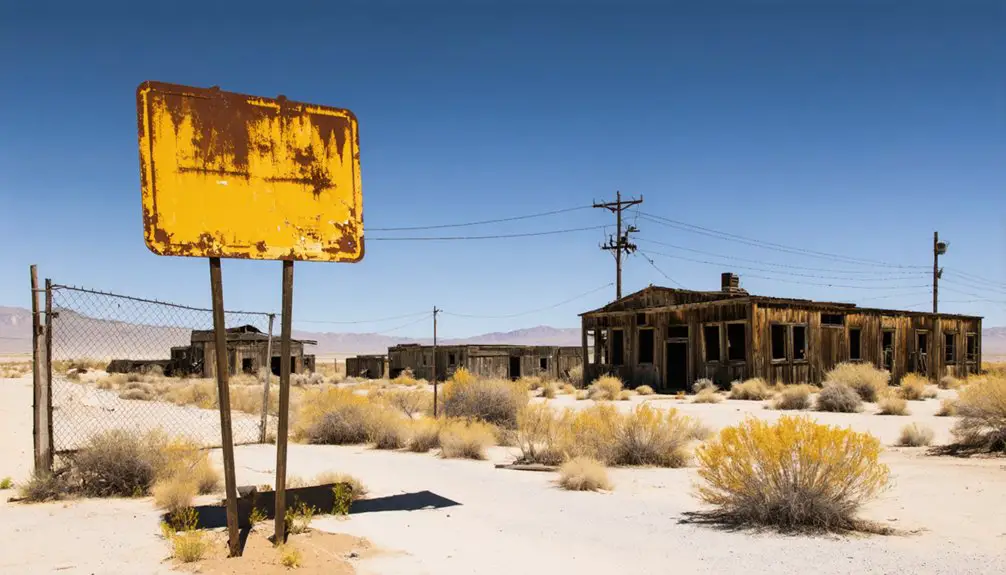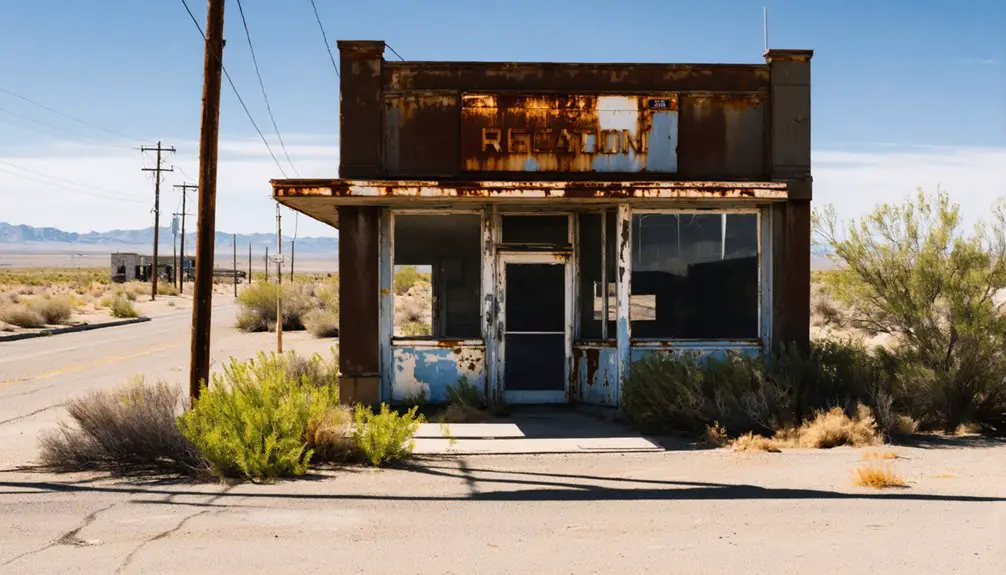You’ll find Hanford’s story begins as a thriving agricultural settlement established in 1907 along Washington’s Columbia River. The community of 1,400 residents cultivated fertile farmland until 1943, when the U.S. government gave them just 30 days to evacuate for the Manhattan Project’s plutonium production facility. Today, you can visit remnants of the original town, including Hanford High School and the Bruggemann warehouse, which stand as silent witnesses to this dramatic transformation.
Key Takeaways
- Hanford transformed from a thriving farming community of 1,400 residents into a ghost town when the Manhattan Project forcibly evicted inhabitants in 1943.
- Residents received short-notice eviction orders, giving them between 28 to 90 days to abandon their homes and farmlands.
- The agricultural town’s displacement led to the destruction of orchards, homes, and businesses to make way for nuclear facilities.
- Only a few original structures remain today, including Hanford High School, the Bruggemann warehouse, and a local power station.
- The site’s transformation ended a prosperous farming era that began in 1907 with the Hanford Irrigation & Power Company’s establishment.
The Birth of an Agricultural Community
When irrigation transformed the arid steppes of southeastern Washington in 1907, the Hanford Irrigation & Power Company established the company town of Hanford along the Columbia River.
You’ll find the roots of this agricultural innovation in the pioneering efforts of the Priest Rapids Irrigation & Power Company, which began regional irrigation projects in 1905.
The completion of the Hanford Ditch in 1907 marked a pivotal moment in irrigation history, channeling life-giving water from Coyote Rapids to parched farmlands.
The Hanford Ditch transformed desert into farmland, carrying precious water from Coyote Rapids across southeastern Washington’s arid landscape.
Under the leadership of entrepreneur Manley Bostwick Haynes and Judge Cornelius Hanford, the town flourished seven miles downstream from White Bluffs.
The strategic location and irrigation infrastructure turned harsh shrubsteppe into fertile soil, enabling you to witness the birth of a thriving farming community sustained by the mighty Columbia River. The town’s population quickly grew to 200-300 residents by 1908. By 1940, this agricultural settlement had grown into a substantial community of 463 residents.
Native American Heritage and Early Settlement
Long before irrigation transformed the Hanford landscape, Native American tribes made their home at the confluence of the Yakima, Snake, and Columbia rivers for more than ten thousand years.
Archaeological heritage reveals their deep connection to these ancestral lands through historic sites including pit houses, quarries, and spirit quest locations.
The tribes suffered greatly when the US government forcibly removed them from their traditional lands in 1943.
Here’s what you’ll discover about their tribal resilience:
- The Wanapum called the Columbia “Nch’i-Wana” (Big River), central to their spiritual practices.
- Native traditions involved seasonal migrations between river valleys and alpine regions.
- Resource gathering included fishing, hunting, and harvesting plant foods.
- Cultural significance of the area is evidenced by Columbia River gem points, recognized by Smithsonian archaeologists in 1926.
Despite the 1855 Stevens treaties attempting to restrict their freedom, many tribes continued their traditional ways until the 1943 Hanford displacement. The native tribes’ struggle for recognition continued when they rejected annual cash payments offered as compensation for their displaced lands.
Daily Life in Pre-War Hanford
Before its wartime transformation, you’d find Hanford’s residents gathering at multiple churches, the local high school built in 1917, and businesses like the Planters Hotel and Columbia Hotel.
You could watch farmers cultivating soft fruits, berries, grapes, and asparagus in the fertile Priest Rapids Valley, with produce shipping via the Chicago, Milwaukee and St. Paul Railroad line that arrived in 1913.
Your banking needs would be met at establishments like Jahnke and Parker Bank, while the town’s educational services centered around the brick high school that served local children.
The area’s original population of about 1,400 settlers would soon be displaced to make way for the Manhattan Project’s massive nuclear facility.
In early 1943, residents received 28 to 90 days to vacate their homes and properties as the government prepared the site for wartime operations.
Community Gathering Spots
During Hanford’s early years, residents developed a rich tapestry of community gathering spots that shaped the area’s social fabric.
You’d find vibrant church activities expanding from army chapels into schools and grange halls, while the Morning Star Baptist Church served as a significant anchor for the African American community during segregation.
Key community gathering locations included:
- The Desert Inn (Transient Quarters), designed by Gustav Pehrson
- White Bluffs’ stores, bank, and ice cream parlor
- Schools that doubled as social venues after hours
- Religious facilities that hosted community gatherings and Sunday school
The Hanford Engineer Works Village’s planned communal spaces fostered social cohesion, while the White Bluffs Inn and local businesses created natural meeting points where you’d find neighbors connecting and building lasting relationships. The first formal church services began in Christmas 1944, marking a significant milestone in community development.
The White Bluffs bank, established in the region’s early settlement period of 1861, remains one of the few surviving structures from the pre-war era.
Farming and Local Economy
While the arid landscape of Hanford initially seemed inhospitable to agriculture, the establishment of the Hanford Irrigation and Power Company (HIPC) in the early 1900s transformed the region into productive farmland.
You’d find irrigated acres selling for $40, though the porous soil created ongoing maintenance challenges for the system.
The region’s crop diversity flourished as farmers cultivated wheat, barley, potatoes, and soft fruits.
You could witness economic stability take root as the Chicago, Milwaukee and St. Paul Railroad’s 1913 arrival provided vital market access for local produce.
The combination of HIPC-sponsored ferries and improved rail infrastructure connected you to broader markets, ensuring profitable distribution of your harvest.
This agricultural prosperity continued until 1943, when the federal government acquired the land for wartime purposes.
Small-Town Education Services
As Hanford’s population grew in the early 1900s, its educational facilities evolved from a single multipurpose building that served as both school and church into a more extensive system. By 1917, you’d find a dedicated high school that strengthened the town’s community identity through formalized secondary education. Racial segregation meant that students of color faced unequal access to these educational opportunities.
The small-town educational experience included:
- Small class sizes with multi-age group learning
- School schedules aligned with farming seasons
- High school graduation rates reaching 74.3% by the 1950s
- Strong integration with local churches and social networks
This educational framework served Hanford until 1943, when wartime demands forced evacuation. The high school building was converted to project offices, and students relocated to nearby communities like Richland, where new suburban-style schools emerged to serve the incoming workforce. The residents of these communities were given only 90 days to vacate their homes and schools when the government acquired the land for the Manhattan Project.
The Manhattan Project’s Dramatic Arrival

The Manhattan Project‘s transformation of Hanford, Washington began in late 1942 when military strategists identified the area’s potential for plutonium production. The site’s remote location, abundant electricity from Grand Coulee Dam, and cooling water from the Columbia River made it ideal for the top-secret mission.
Under intense wartime urgency, the government gave residents of White Bluffs and Hanford just 30 days to evacuate their homes.
DuPont launched a massive construction effort, building hundreds of structures including nuclear reactors, processing plants, and worker facilities. Within 30 months, they’d constructed 554 buildings, 386 miles of roads, and 158 miles of railroad tracks.
The rural farming community transformed into a classified industrial complex that would help end World War II through its vital role in plutonium production.
Displacement and Forced Exodus
During early 1943, government surveyors descended upon Hanford to assess land requisition needs, marking the start of a contentious displacement process.
The displacement trauma intensified when residents received formal eviction notices in March, allowing just 30 days to abandon their homes and livelihoods.
Despite community resilience, you’ll understand the profound impact through these key developments:
- Courts authorized government acquisition on February 23, 1943
- Property assessments often undervalued residents’ land by up to 600%
- Native American tribes lost ancestral territories and fishing rights
- By 1946, hundreds of compensation claims remained unsettled
The government’s actions erased thriving agricultural communities, transforming farmland into restricted nuclear facilities.
While some residents fought through legal channels, the lack of transparency and rushed timeline left deep scars across displaced populations.
Building America’s Nuclear Arsenal

During World War II’s Manhattan Project, you’d have witnessed an unprecedented construction effort at Hanford, where crews built three nuclear reactors and five processing facilities in just over two years.
You’d have seen more than 50,000 workers, most unaware of their project’s true purpose, laboring around the clock to construct massive concrete structures designed to produce plutonium for atomic weapons.
The urgency of wartime pressure drove this remarkable achievement, as B Reactor began producing weapons-grade plutonium by September 1944, ultimately fueling the bomb dropped on Nagasaki.
Rapid Construction Under Pressure
Under immense wartime pressure, construction of the Hanford Engineer Works commenced in 1942 after military planners selected the remote Washington site for its ideal combination of isolation, abundant Columbia River cooling water, and proximity to hydroelectric power from nearby dams.
The rapid construction under wartime urgency achieved unprecedented milestones:
- You’d witness 51,000 workers building 554 buildings, 386 miles of road, and 158 miles of railroad in just 30 months.
- The world’s first three production-scale nuclear reactors rose from bare ground, spaced miles apart for safety.
- B Reactor, completed in just 11 months, became operational by September 1944.
- Three massive chemical separation plants emerged 10 miles south, protected by natural barriers of Gable Mountain and Butte.
Manhattan Project’s Hidden Workforce
As the Manhattan Project‘s urgent mission expanded in 1943, a massive workforce of 51,000 individuals converged on Hanford to build America’s nuclear arsenal. You’d find workers from across America, including 15,000 African Americans who formed a critical part of this hidden labor force. They constructed over 554 buildings, 386 miles of roads, and 158 miles of railroad tracks in record time.
The racial dynamics of the era shaped life at Hanford, with segregated housing and facilities for African American workers. While the project offered employment opportunities, you’d see stark contrasts in living conditions.
Eight massive cafeterias, stores, and recreational facilities supported the workforce, but discriminatory practices remained prevalent. This diverse workforce transformed Hanford from rural farmland into an essential nuclear production center, despite challenging social conditions.
Environmental Impact and Contamination
While the Hanford site played a crucial role in nuclear weapons production, it left behind one of America’s most severe environmental contamination legacies.
You’ll find the scale of contamination almost incomprehensible, with over 400 billion gallons of radioactive waste seeping into soil and groundwater.
The environmental restoration challenges you’re witnessing today include:
- 56 million gallons of waste stored in 177 underground tanks
- 25 million cubic feet of solid radioactive waste
- Widespread groundwater contamination with technetium-99 and uranium
- Persistent Columbia River ecosystem damage affecting wildlife and water quality
The site’s contamination continues to threaten your freedom to safely access local water resources, with radioactive waste impacting everything from river sediments to agricultural areas.
You’ll see ongoing cleanup efforts working to contain and remediate these hazards, though complete restoration remains decades away.
The Human Cost of Nuclear Progress

When the U.S. government seized 586 square miles for the Manhattan Project in 1943, you’d have witnessed the forced evacuation of farmers, settlers, and Native American communities from their ancestral lands.
You’ll find that the original inhabitants received minimal compensation, with many families given just 30 days to abandon generations of agricultural investment and cultural heritage.
Your understanding of the human toll deepens when examining how the site’s subsequent nuclear operations exposed thousands of workers to dangerous levels of radiation and toxic chemical vapors, leading to severe health consequences that persist today.
Farmers Forced From Home
The Manhattan Project‘s decision to construct the Hanford nuclear site in 1943 forced hundreds of farming families from their homes with only 90 days’ notice, permanently altering the agricultural landscape of southeastern Washington.
The displacement trauma shattered tight-knit communities as farmers faced insurmountable economic hardships, losing generations of agricultural heritage.
You’ll find the government’s harsh timeline left families with impossible choices:
- Accept undervalued compensation excluding crops and equipment
- Challenge offers legally, facing pressure to settle quickly
- Abandon farms with no replacement land options
- Relocate without adequate support or infrastructure
The once-thriving towns of Hanford, White Bluffs, and Richland vanished beneath the shadow of nuclear progress.
DuPont’s rapid construction timeline prioritized wartime urgency over fair treatment, leaving displaced families without recourse or means to preserve their farming traditions.
Native Communities Lose Land
Beyond the displacement of farming families, Native American tribes endured devastating losses as the Manhattan Project commandeered their ancestral territories in 1943.
The Wanapum, Yakima Nation, Umatilla, and Nez Perce tribes lost access to lands of immense cultural significance along the Columbia River, disrupting centuries-old practices and spiritual connections.
You’ll find that tribal negotiations with Army officials yielded only limited fishing and ceremonial rights, which were later revoked for security reasons.
Bulldozers destroyed Native settlements and even exhumed burial grounds, effectively erasing physical evidence of Indigenous presence.
The government’s actions severed tribal access to traditional hunting grounds, fishing spots, and sacred sites where, according to tribal beliefs, the Creator made the first man.
This forced removal dealt a profound blow to cultural knowledge transmission and community cohesion.
Workers Face Radiation Exposure
During Hanford’s four decades of nuclear weapons production, workers faced severe occupational hazards from prolonged exposure to ionizing radiation and toxic substances. The health impacts devastated countless lives through various exposure routes and contamination events.
Key radiation exposure pathways that affected workers:
- Inhalation of airborne plutonium, americium, and uranium during processing
- Direct contact with radioactive particles during chemical explosions
- Ingestion of contaminated resources from discharged waste
- Contact with contaminated work surfaces and equipment
The consequences proved devastating, with elevated rates of brain cancer, leukemia, and blood disorders compared to the general population.
While federal programs now provide over $26 billion in compensation, the legacy of Hanford’s radiation exposure continues through chronic illnesses and ongoing medical treatments for surviving workers.
Preserving the Ghost Town’s Memory
Since its designation as a historic site, preservation efforts at Hanford have gained substantial momentum through strategic funding and community involvement.
You’ll find the Department of Energy’s $5 million allocation in 2012 has enabled critical historical preservation initiatives, including plans to restore the Bruggemann building as an interpretive center.
The B Reactor’s transformation stands as a proof of successful community engagement, having secured National Historic Landmark status in 2008 and joining the Manhattan Project National Historical Park in 2015.
You can now tour this facility alongside 80,000 other visitors who’ve explored it since 2009. Local organizations like the B Reactor Museum Association and REACH Museum continue driving preservation efforts, ensuring Hanford’s legacy through physical restoration, educational programs, and cultural documentation initiatives.
Legacy of a Lost Community
When the U.S. government ordered the evacuation of Hanford and White Bluffs in early 1943, residents faced an abrupt 30-day notice that would permanently alter their community’s existence.
The cultural displacement affected both settlers and Native American tribes who’d inhabited the land for generations, creating a lasting impact on the region’s agricultural heritage.
The transformation of this farming community into a nuclear facility resulted in:
- Loss of 554 buildings including homes, businesses, and community centers
- Displacement of multiple Native American tribes without proper compensation
- Destruction of thriving orchards and farmland spanning thousands of acres
- Environmental contamination that continues to affect the region today
You’ll find few physical remnants of the original town, save for the Hanford High School, Bruggeman warehouse, and power station – silent witnesses to a community’s sacrifice for national security.
Frequently Asked Questions
What Happened to the Cemetery When Hanford Residents Were Forced to Relocate?
You’ll find the cemetery relocation moved roughly 1,500 graves, mostly Native American burial sites, to Prosser Cemetery in 1943. The government funded this transfer and notified families about their relatives’ new locations.
Are There Any Original Hanford Buildings Still Standing on the Site Today?
Out of hundreds of original structures, you’ll find only three surviving buildings: the Hanford High School ruins, Bruggeman warehouse, and Hanford Irrigation and Power Co. Station – rare examples of preserved pre-nuclear architecture.
What Compensation Did the Government Provide for Seized Farmland and Property?
You’d receive compensation based on government property assessments, though initial payments often excluded buildings, orchards, and improvements. Many families challenged low valuations through legal action to obtain fairer settlements.
How Many Workers Died During the Construction of Hanford’s Nuclear Facilities?
While worker safety and construction hazards were concerns, you can’t find exact death counts during Hanford’s construction. Studies tracked overall mortality but didn’t specifically document construction-phase fatalities.
Can Former Residents or Their Descendants Visit Their Old Property Locations?
You can’t freely visit your ancestral property at the site. Property access and descendant rights are strictly controlled – visits are only permitted through official guided tours due to safety restrictions.
References
- https://www.visittri-cities.com/heritage/town-of-hanford/
- https://www.youtube.com/watch?v=9pDVMnmTazc
- https://www.hanford.gov/page.cfm/understandPAST
- https://en.wikipedia.org/wiki/Hanford_Site
- https://ahf.nuclearmuseum.org/ahf/location/hanford-wa/
- https://www.epa.gov/fedfac/hanford-site-spotlight
- http://www.hanfordhistory.com/items/show/4612
- http://www.hanfordhistory.com/items/show/4615
- https://www.nps.gov/mapr/about-hanford.htm
- https://www.ghosttownsofwashington.com/post/hanford-wa



